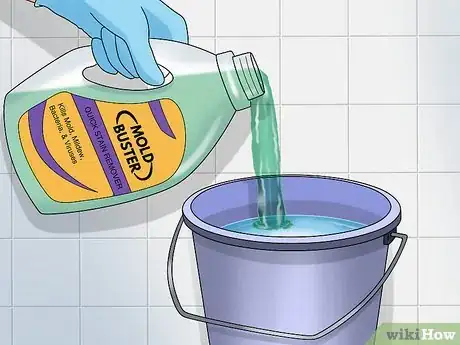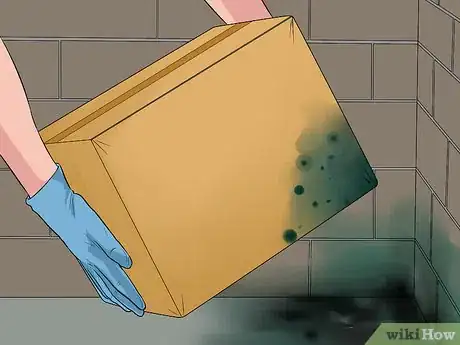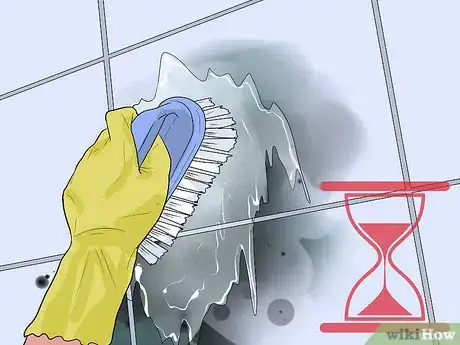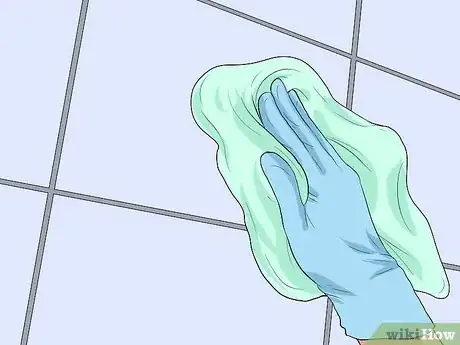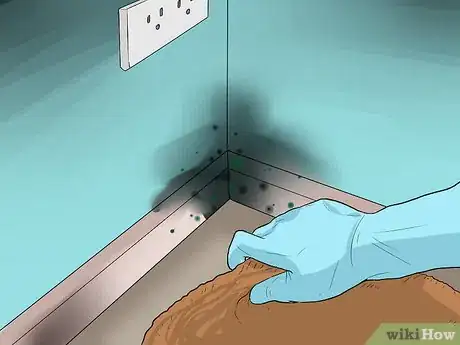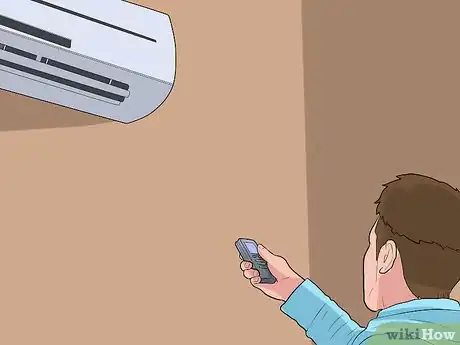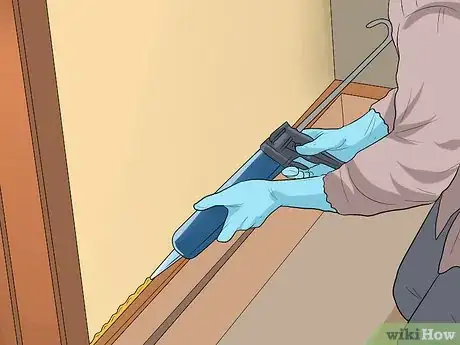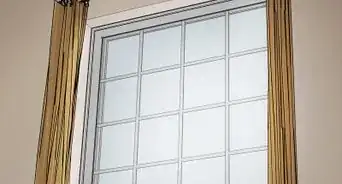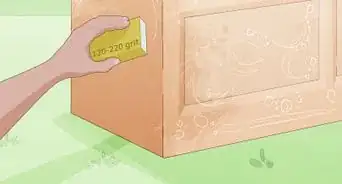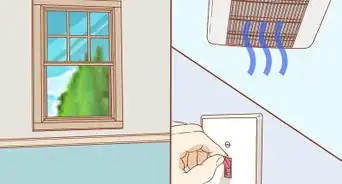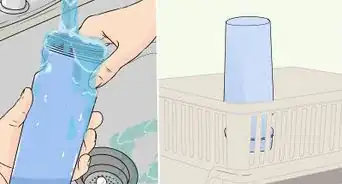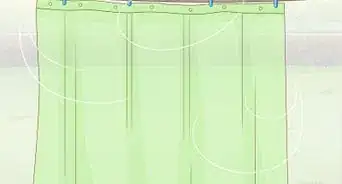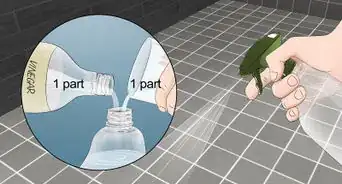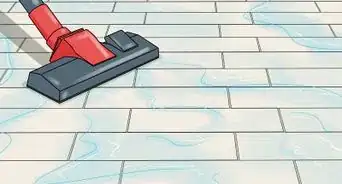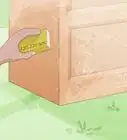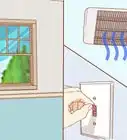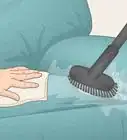This article was co-authored by Mike Kapur. Mike Kapur is a home inspector and the owner of Sonic Home Inspections, a home inspection company in Westchester, New York. With over 15 years of experience in pre-inspecting properties, Mike specializes in mold, radon, asbestos, lead, water, and air quality testing as well as hazardous materials, pest, infrared, and general home inspections. Prior to founding Sonic Home Inspections, Mike worked pre-inspecting apartments. Mike holds a BS in Accounting from Queens College and is a Certified Mold Assessor in the state of New York.
There are 10 references cited in this article, which can be found at the bottom of the page.
This article has been viewed 86,814 times.
Choose from several cleaning agents to remove mold from concrete. Spot test a small area with your chosen cleaning agent to make sure no damage occurs. You’ll need to wear protective gear and scrub the moldy areas vigorously. Rinse exterior concrete afterwards with a power washer. Interior concrete can be wiped dry. Merely killing mold won’t prevent it from returning, so make sure to address the water source that is causing the mold.
Steps
Removing the Mold
-
1Choose a cleaning agent to treat the mold, like white vinegar or bleach. You can use a mold-killing detergent, diluted bleach, vinegar, or a commercial cleaner made specifically for killing mold.[1] Don’t mix anything other than water with bleach, as certain cleaning agents can produce highly toxic fumes when mixed with bleach.[2]
-
2Remove affected items. Any organic material adjacent to the moldy area can be infected. Throw away any disposables like cardboard boxes. Set aside other removable items like furniture or area rugs.Advertisement
-
3Apply the solution. Use a heavy duty sponge or scrub brush to apply your chosen cleaning solution to all visible moldy areas on the concrete. Scrub the areas vigorously. If you’re using mold-killing detergent, apply it directly to the spots and scrub it with a bristle brush.[6]
- Don’t use a wire brush, which can scratch concrete.[7]
- Wear old clothes, rubber gloves, safety goggles and a respirator or dust mask.
-
4Let the solution soak. If the spots aren’t lifting, leave the solution to sit for several minutes. Then scrub the areas with the solution until the mold is gone.[8]
-
5Rinse outdoor concrete. Use a hot water pressure washer for the fastest and most effective rinse. Wear safety goggles, sturdy footwear and long pants. Use a pressure rating of at least 3000 psi with a flow rate of at least four gpm (gallons per minute).[9] This should lift any organic matter that has seeped into the pores of the concrete.[10] If you don’t want to use a pressure washer, try a regular water hose.[11]
- You can rent a pressure washer at a home or building supply store. You may need a van, pickup truck or SUV to transport it, and a friend to help load and unload it.[12]
- Ask the rental agent how to use the washer and to give you any safety precautions. Find out if the washer comes with nozzles. Don’t use settings finer than fifteen degrees. Never use a zero degree nozzle on a pressure washer.
-
6Dry interior concrete with a towel. Once it’s dry, inspect carefully for any mold that may not have been cleaned. If there is still visible mold, rinse the area clean and try one of the stronger methods you haven’t used yet: diluted bleach or commercial cleaner.[13]
-
7Clean items you’ve set aside before placing them back in the area. Leather, wood or inorganic furniture can be deep cleaned. Upholstered furniture with visible mold will need to be disposed of or reupholstered by a professional. Carpet that shows significant mold growth or is soaked completely through will need to be removed.
Eliminating the Source of Moisture
-
1Check the land for sloping and debris. Dirt should be slightly sloped away from the house so that water will travel away from the perimeter rather than pool up against the outer walls. Don’t allow wet leaves or other debris to pile up against the exterior walls of your home.[14]
- Pooling water can seep into the home and cause mold to grow inside the house.
- If your driveway is showing signs of mold, consider removing trees or shrubbery that are blocking sunlight on your driveway. Mold thrives in damp and shady areas.[15]
-
2Examine how water is discharged outside. Sump pumps should discharge water at least twenty feet from your home. Your gutters should expel water at least six feet away from the exterior walls. If your gutters are releasing water too close to the home, install gutter extenders.[16]
-
3Check for water seepage. Make sure none of your outside hose spots are dripping. Examine the perimeter of the building for any potential water dripping or seepage.
-
4
-
5Reduce the humidity indoors. If your mold problem is indoors, increase the ventilation to prevent warm and stagnant air where mold can thrive. Make sure large appliances are vented, such as your washer and dryer. Make sure kitchens and bathrooms are well ventilated. Run air conditioners and dehumidifiers as needed.[18]
-
6Waterproof the concrete. Seal the concrete with water-proofing chemicals. Seal any cracks in the concrete walkway around your home with concrete, caulking or tar.[19] If you plan to paint concrete walls, use a waterproof sealant first, then apply stain-blocking primer and paint.[20]
- For outdoors, try a high quality acrylic sealer made for exterior use. If your weather tends to be warm and humid, look for a low-solids solvent-based sealer. Choose dry, sunny weather and allow the sealer to dry for at least two to three days.[21]
Expert Q&A
Did you know you can get expert answers for this article?
Unlock expert answers by supporting wikiHow
-
QuestionWhat household products will kill bleach?
 Mike KapurMike Kapur is a home inspector and the owner of Sonic Home Inspections, a home inspection company in Westchester, New York. With over 15 years of experience in pre-inspecting properties, Mike specializes in mold, radon, asbestos, lead, water, and air quality testing as well as hazardous materials, pest, infrared, and general home inspections. Prior to founding Sonic Home Inspections, Mike worked pre-inspecting apartments. Mike holds a BS in Accounting from Queens College and is a Certified Mold Assessor in the state of New York.
Mike KapurMike Kapur is a home inspector and the owner of Sonic Home Inspections, a home inspection company in Westchester, New York. With over 15 years of experience in pre-inspecting properties, Mike specializes in mold, radon, asbestos, lead, water, and air quality testing as well as hazardous materials, pest, infrared, and general home inspections. Prior to founding Sonic Home Inspections, Mike worked pre-inspecting apartments. Mike holds a BS in Accounting from Queens College and is a Certified Mold Assessor in the state of New York.
Mold Removal Specialist
Warnings
- If you have large amounts of mold, more than ten square feet, it is best to have it professionally removed.[24]⧼thumbs_response⧽
- Be careful not to rinse chemicals away onto plants.[25]⧼thumbs_response⧽
- If your concrete countertop has mold, consult with the manufacturer about what stain removal technique to use.[26]⧼thumbs_response⧽
References
- ↑ https://www.concretenetwork.com/fix-concrete-cleaning/clean-mold-on-concrete.html
- ↑ http://www.womansday.com/home/organizing-cleaning/tips/a1597/get-rid-of-mildew-for-good-107485/
- ↑ https://projects.truevalue.com/maintenance_and_repair/windows_and_walls/remove_mold_from_walls.aspx
- ↑ Mike Kapur. Certified Mold Assessor & Home Inspector, Sonic Home Inspections. Expert Interview. 19 August 2020.
- ↑ https://www.installitdirect.com/blog/concrete-stain-removal/
- ↑ https://www.bobvila.com/articles/how-to-clean-concrete/
- ↑ https://www.installitdirect.com/blog/concrete-stain-removal/
- ↑ https://projects.truevalue.com/maintenance_and_repair/windows_and_walls/remove_mold_from_walls.aspx
- ↑ https://www.concretenetwork.com/concrete/cleaning_concrete/equipment_options.htm
- ↑ https://www.concretenetwork.com/fix-concrete-cleaning/clean-mold-on-concrete.html
- ↑ https://www.hunker.com/12392335/how-to-remove-green-mold-from-concrete
- ↑ https://www.familyhandyman.com/painting/how-to-pressure-wash-a-house/view-all
- ↑ https://projects.truevalue.com/maintenance_and_repair/windows_and_walls/remove_mold_from_walls.aspx
- ↑ http://moldmanusa.com/106-tips-about-mold-mold-remediation-mold-removal-mold-testing-and-mold-prevention/
- ↑ https://www.concretenetwork.com/fix-concrete-cleaning/clean-mold-on-concrete.html
- ↑ http://moldmanusa.com/106-tips-about-mold-mold-remediation-mold-removal-mold-testing-and-mold-prevention/
- ↑ https://projects.truevalue.com/maintenance_and_repair/windows_and_walls/remove_mold_from_walls.aspx
- ↑ https://projects.truevalue.com/maintenance_and_repair/windows_and_walls/remove_mold_from_walls.aspx
- ↑ http://moldmanusa.com/106-tips-about-mold-mold-remediation-mold-removal-mold-testing-and-mold-prevention/
- ↑ https://projects.truevalue.com/maintenance_and_repair/windows_and_walls/remove_mold_from_walls.aspx
- ↑ https://www.concretenetwork.com/fix-concrete-cleaning/clean-mold-on-concrete.html
- ↑ Mike Kapur. Certified Mold Assessor & Home Inspector, Sonic Home Inspections. Expert Interview. 19 August 2020.
- ↑ Mike Kapur. Certified Mold Assessor & Home Inspector, Sonic Home Inspections. Expert Interview. 19 August 2020.
- ↑ https://projects.truevalue.com/maintenance_and_repair/windows_and_walls/remove_mold_from_walls.aspx
- ↑ https://www.installitdirect.com/blog/concrete-stain-removal/
- ↑ https://www.installitdirect.com/blog/concrete-stain-removal/
About This Article
To clean mold off concrete, you can use either a commercial mold-killing product or a diluted bleach solution made with 3 parts water to 1 part bleach. First, put on safety gear such as goggles, gloves, and a respirator to protect yourself from the mold and fumes. Then, apply the solution with a scrub brush and let it sit for a few minutes. If you're working on exterior concrete, you can use a pressure washer or a hose to to rinse the area once it’s clean. For interior concrete, dry the area with a clean towel. For more information on cleaning mold off concrete, like how to eliminate the source of moisture, read on!
